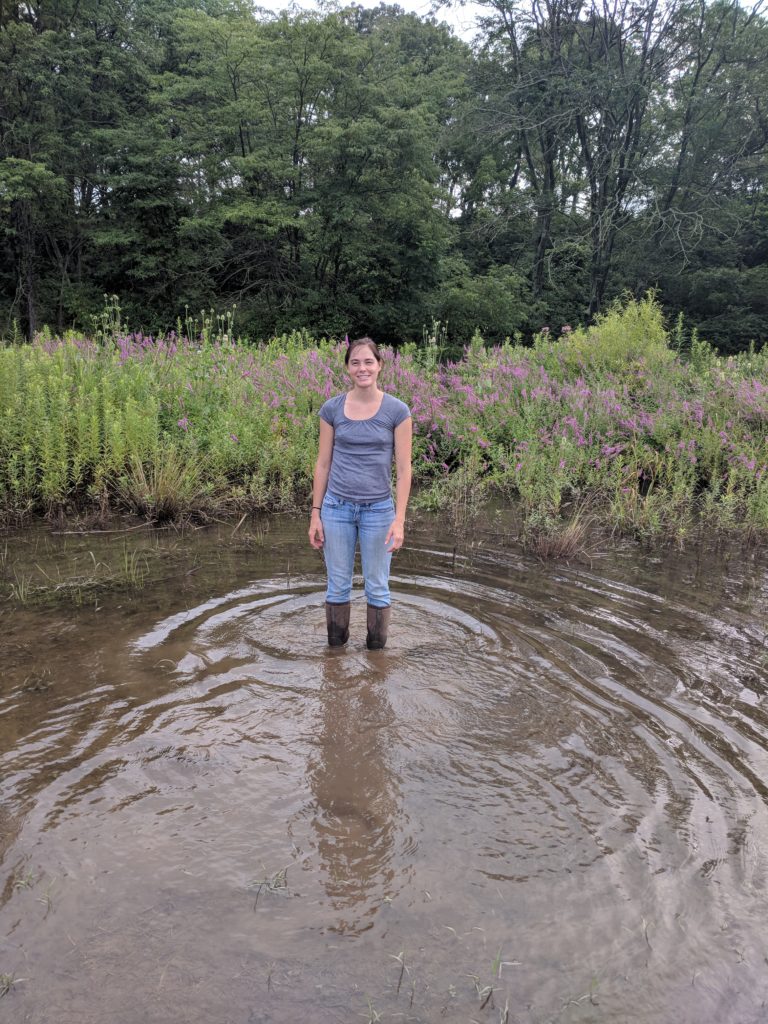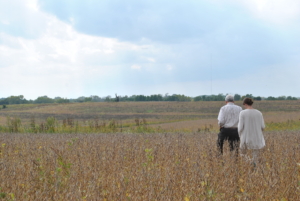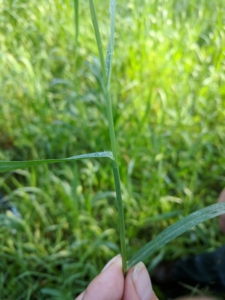A team at Penn State University (PSU) is helping farmers understand how stream buffers planted with perennial grasses could be a way to make money. For example, switchgrass can be sold for a number of industrial purposes, and may even be as profitable as planting corn. But, oftentimes farmers have to see it to believe it. “We really need to demonstrate the successful options to farmers,” explained Steph Herbstritt, a Penn State doctoral student in Agricultural Engineering.

Herbstritt ankle deep in water on the edge of one of their field sites.
Herbstritt grew up on a farm in Bellefonte, Pennsylvania and understands the barriers to getting farmers excited about stream buffers. Along with her advisor, Tom Richard, Herbstritt has planted grasses at two field sites in State College and has a third planned in Lancaster this Spring. They also just received a grant with ClearWater Conservancy to plant 33 more acres. By working with engineers, farmers, and researchers, they are trying to figure out where current and future flooding will be, where annual crops might not make sense any more and where perennial grasses might be resilient to flooding. “When the flooding is impacting [the farmers] personally,” explained Herbstritt, “if they can plant something that can withstand the flood impacts, that can be a huge benefit to them, especially if it’s profitable.”
Switchgrass sells at the high end for $150/ton, and farmers could harvest 4-6 tons per acre planted. Farmers can mow and bail the grass, then sell it to companies that can make erosion control socks, pellets that can be used for absorption, or poultry bedding. There is even a hospital that is using switchgrass as boiler fuel to heat the facility. The Department of Energy is interested in switchgrass as a sustainable biofuel. With all these potential uses of the grasses, Herbstritt knows farmers could benefit hugely from the economic stability of the grasses. “We think grasses can help solve our water quality problem, but we also think it can also help solve our farm economy problem,” she said. “Many farmers are focused on just corn or just dairy. By diversifying what they are planting, they might be more resilient to fluctuations in the economy.” The team is now looking at the size of switchgrass markets to see if this model could be scaled up and spread to other properties.

Herbstritt and Richard walking through a soybean/grass field in Iowa.
The team is determined to normalize buffers for farmers, which seems like some serious social science work for a group of engineers. Herbstritt explained that her background in the farm community helps her “bridge the gap between new knowledge and learning from farmers, while also educating farmers on potential opportunities.” She knows that solutions cannot be implemented in a one-size-fits-all approach: “When we talk to farmers, we have to understand their needs, beliefs, and values,” she explained, “and we need to have demonstrated successful options that fit those.” Her goal is to use the demonstration sites to help farmers get over the hurdle, and then use farmers who have already installed grass buffers as an example to their neighbors.
In November, stakeholders had the chance to share their findings at a workshop that Herbstritt and some of her colleagues organized, in conjunction with a Scientific and Technical Advisory Committee (STAC) workshop. Some of the key issues that the workshop addressed included flooding and the need for success stories from farmers. The workshop also gave them an opportunity to talk about recent science updates, such as new research on forest buffers. The group is now working on distilling the lessons learned from the workshop and release a report in the near future.

Close up of a switchgrass plant.
Herbstritt is excited about several applications of this work like the potential to use grass as a feedstock for renewable energy. And not just ethanol. In the future, dairy farms across the Bay might be able to co-digest grass with manure to produce biogas for heat and electricity. Microbes digest organic material like manure and grass to produce methane. “I think biogas is such a cool opportunity for farmers,” explained Herbstritt. “Tom has always said there is a synergy between water quality and sustainable energy.” At the present, perennial grasses could potentially be used to accelerate buffers across the Chesapeake Bay. If farmers can get onboard with grass, maybe that’s a start to getting more trees and more buffers. She is excited to see the results of her research and is hopeful that her field sites will find that grasses can improve water quality while being profitable. “I think we can plant perennial grasses anywhere,” she said. “And there’s a huge opportunity to plant grass buffers across the Bay.” By normalizing buffers in Pennsylvania, Herbstritt and their team could help solve water quality issues across the Chesapeake alongside the farmer.
